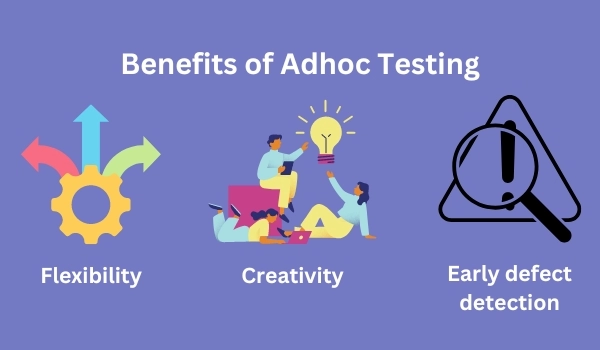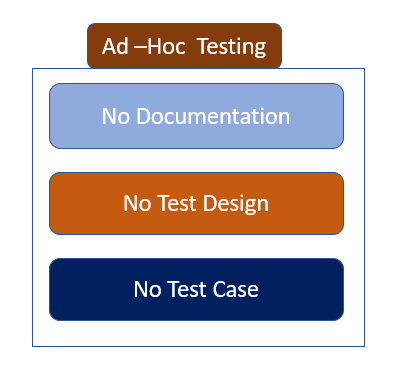
Hey All
In this tutorial, we would discuss about the Ad Hoc Testing.
What is Ad Hoc Testing?

Ad hoc testing, also known as exploratory testing or random testing, is a software testing approach performed without predefined test plans or cases. Instead, testers rely on intuition, creativity, and experience to identify defects in the software. It is often used after formal testing to uncover additional bugs that might have been missed.
Ad hoc testing is an informal and unstructured software testing technique where testing is performed without any specific test cases or plan. It is an unplanned approach to testing, often used when there are time constraints or limited documentation available about the software being tested. In ad hoc testing, testers explore the application randomly, attempting to find defects without following any predefined test scripts.
Benefits of Ad Hoc Testing:
- Flexibility and Adaptability: Ad hoc testing is highly flexible, allowing testers to adapt their approach based on their intuition and the software’s behavior.
- Quick and Minimal Preparation: This method can be executed swiftly without extensive preparation, making it useful for rapid assessment.
- Comprehensive Testing: Testers can explore any part of the software, whether formally tested or not, making it an excellent method for thorough evaluation.
- Bug Identification: Ad hoc testing excels at finding elusive bugs that might be challenging to uncover through formal testing methods.
Disadvantages of Ad Hoc Testing:
- Lack of Systematic Approach: Ad hoc testing lacks the systematic approach of formal testing, potentially leading to overlooking certain bugs.
- Reproducibility and Documentation: Reproducing and documenting ad hoc tests can be challenging, making it difficult to track progress and identify areas needing further testing.
- Time-Consuming: For large or complex software systems, ad hoc testing can be time-consuming, affecting overall testing efficiency.
Tips for Effective Ad Hoc Testing:
- Leverage Intuition and Experience: Think from an end-user perspective, considering likely areas where bugs might occur based on your experience and understanding of the software.
- Embrace Creativity: Experiment with different ways of using the software, exploring new functionalities to uncover potential issues.
- Utilize Test Data: Incorporate diverse test data to explore various scenarios, helping identify bugs that might not surface during regular usage.
- Document Findings: Despite its informal nature, document your findings meticulously. Keeping track of identified issues aids in monitoring progress and highlighting areas for further investigation.
Ad hoc testing, when employed effectively, serves as a valuable tool for testers to uncover hidden defects swiftly and creatively. While not a substitute for formal testing, its adaptability and exploratory nature make it a crucial component of the testing toolkit.
Spontaneous Testing Approach in Ad Hoc Testing

Ad hoc testing is a spontaneous approach to software testing that is performed without any predefined test plan or test cases. Testers use their intuition, creativity, and experience to identify defects in the software. This approach can be very effective for finding bugs, especially for complex or difficult-to-test software.
One of the key benefits of ad hoc testing is its spontaneity. Testers can start testing immediately, without having to spend time developing test cases. This can be especially helpful for finding bugs in early versions of software, when the functionality is still changing rapidly.
Another benefit of ad hoc testing is its flexibility. Testers can test any part of the software, at any time. This can be helpful for finding bugs that are related to specific user scenarios or that are difficult to reproduce.
However, there are also some challenges associated with ad hoc testing. One challenge is that it can be difficult to track progress and identify areas that need further testing. This is because ad hoc tests are not typically documented in advance.
Another challenge is that ad hoc testing can be time-consuming, especially for large or complex software systems. This is because testers need to spend more time thinking about how to test the software and exploring different areas.
Overall, ad hoc testing is a valuable tool for software testers. It can be used to find bugs that may be difficult to find using formal testing methods, and it can be performed quickly and with minimal preparation. However, it is important to note that ad hoc testing is not a replacement for formal testing.
Here are some tips for using the spontaneous testing approach of ad hoc testing effectively:
- Start small. Focus on testing a small area of the software at a time. This will help you to find bugs quickly and easily.
- Use your intuition and experience. Think about how you would use the software and what areas are most likely to contain bugs.
- Be creative. Don’t be afraid to try new things and experiment with different ways of using the software.
- Use test data. Test data can help you to find bugs that may not be found using normal usage of the software.
- Take breaks. Ad hoc testing can be mentally demanding, so it is important to take breaks regularly.
What are the benefits of Spontaneous Testing Approach in Ad Hoc Testing?

Ad hoc testing, driven by its spontaneous approach, offers several distinct advantages in software testing:
- Immediate Issue Detection:
- Testers swiftly identify critical issues by exploring software intuitively, ensuring rapid bug detection.
- Diverse Scenario Exploration:
- Testers simulate various user interactions, enhancing the likelihood of discovering unforeseen issues not covered by formal test cases.
- Innovative Problem Solving:
- Encourages creative thinking, enabling testers to uncover unique defects that might elude traditional testing methods.
- Flexibility and Adaptability:
- Testers can focus on specific software aspects without the constraints of predefined cases, ensuring adaptability to evolving functionalities.
- Early Bug Identification:
- Particularly valuable for early software versions, providing crucial feedback to developers during rapid functionality changes.
- Comprehensive Software Evaluation:
- Enables exploration of intricate system interactions, ensuring a thorough understanding of the software’s behavior in diverse scenarios.
- Cost-Effectiveness:
- Requires minimal resources and preparation, making it a cost-effective method for identifying critical issues.
- Enhanced Creativity:
- Empowers testers to innovate, leading to the discovery of defects not identifiable through conventional testing methods.
- Real-Time Feedback Loop:
- Bugs found are reported promptly, expediting bug-fixing cycles and ensuring efficient issue resolution.
- Encourages Collaboration:
- Fosters teamwork and knowledge sharing among testers, leading to diverse perspectives and a more comprehensive software evaluation.
- User-Centric Testing:
- Facilitates simulation of real-world user interactions, enabling the identification of usability issues and ensuring software meets user expectations.
The spontaneous testing approach in ad hoc testing stands as a dynamic and innovative method for software exploration. Its ability to quickly identify critical defects, its adaptability, and its cost-effectiveness make it a valuable asset in the software testing arsenal. Despite lacking formal structures, its knack for uncovering significant issues swiftly makes it an essential tool in the pursuit of software quality.
What are the potential pitfalls of Spontaneous Testing Approach in Ad Hoc Testing?

While the spontaneous testing approach in software testing offers various advantages, it is not without its challenges. Testers engaging in ad hoc testing may encounter several pitfalls that could impact the effectiveness of their efforts:
- Lack of Reproducibility:
- Challenge: Issues identified through spontaneous testing might be difficult to reproduce systematically, making it challenging for developers to diagnose and fix the problems accurately.
- Mitigation: Testers can focus on providing detailed descriptions and steps taken during testing, aiding developers in understanding and replicating the reported issues.
- Limited Documentation:
- Challenge: Spontaneous testing often lacks structured documentation, making it hard to track the testing progress, identified bugs, and the areas explored.
- Mitigation: Testers should strive to document their findings comprehensively, including screenshots, videos, and detailed notes. Utilizing test management tools can also aid in organized documentation.
- Inconsistent Testing Depth:
- Challenge: Testers might focus on certain functionalities or areas more than others, leading to uneven testing depth and potential oversight of critical features.
- Mitigation: Testers should consciously diversify their exploration, ensuring a balanced approach that covers various aspects of the software. Regular team discussions can help identify and address potential gaps.
- Dependency on Individual Testers:
- Challenge: The effectiveness of spontaneous testing can heavily depend on the skills, intuition, and experience of individual testers, making it less scalable.
- Mitigation: Encourage knowledge sharing and pair testing among team members. Collaboration ensures a collective pool of insights, reducing reliance on individual testers.
- Overlooking Regression Testing:
- Challenge: Spontaneous testing might focus on new features or changes, overlooking regression testing, which ensures existing functionalities remain intact.
- Mitigation: Integrate ad hoc testing with regression testing strategies. Allocating specific time for regression checks ensures that existing functionalities are not compromised during the spontaneous testing process.
- Limited Test Coverage:
- Challenge: Due to the spontaneous nature, testers might overlook certain scenarios or user interactions, leading to incomplete test coverage.
- Mitigation: Employ techniques such as risk-based testing to prioritize critical areas. Regularly updating and diversifying test scenarios can help expand coverage over time.
- Ambiguity in Bug Reporting:
- Challenge: Issues discovered spontaneously might lack clarity in bug reports, making it challenging for developers to understand the problem fully.
- Mitigation: Testers should invest time in crafting clear and concise bug reports. Including steps to reproduce, expected vs. actual outcomes, and system environment details enhances the developer’s understanding.
While spontaneous testing can be a powerful method for detecting issues, testers must be aware of these potential pitfalls. Through meticulous documentation, collaboration, balanced exploration, and structured communication, these challenges can be effectively navigated, ensuring a more successful and impactful spontaneous testing process.
Ad Hoc Testing Without Formal Test Cases

Ad hoc testing, also known as random testing or exploratory testing, is a type of software testing that is performed without any predefined test plan or test cases. Testers use their intuition, creativity, and experience to identify defects in the software. Ad hoc testing is often performed after formal testing has been completed to find any additional bugs that may have been missed.
Ad hoc testing can be a very effective way to find bugs, especially for complex or difficult-to-test software. However, it is important to note that ad hoc testing is not a replacement for formal testing. Formal testing is necessary to ensure that all of the requirements of the software have been tested.
Ad hoc testing, often referred to as testing without formal test cases, is a dynamic and intuitive approach to software quality assurance. In this method, testers explore the software spontaneously, relying on their creativity, intuition, and experience rather than predefined test cases.
Here are some tips for performing ad hoc testing effectively:
- Use your intuition and experience. Think about how you would use the software and what areas are most likely to contain bugs.
- Be creative. Don’t be afraid to try new things and experiment with different ways of using the software.
- Use test data. Test data can help you to find bugs that may not be found using normal usage of the software.
- Document your findings. Even though ad hoc testing is not as systematic as formal testing, it is important to document your findings so that you can track progress and identify areas that need further testing.
Ad hoc testing: an example
Here is an example of how ad hoc testing might be used to test a new e-commerce website:
- The tester starts by browsing the website and using the different features.
- The tester tries to think of different ways that the website could be used and what scenarios might cause bugs.
- The tester tries to reproduce those scenarios and see if they can find any bugs.
- The tester documents any bugs that they find.
The tester can continue testing the website in this way until they are confident that it is free of bugs.
Ad hoc testing can be a very effective way to find bugs, but it is important to use it in conjunction with other testing methods, such as formal testing. By using a variety of testing methods, you can ensure that your software is thoroughly tested and ready for release.
Thanks,






Leave a Reply
You must be logged in to post a comment.